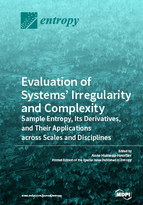Evaluation of Systems’ Irregularity and Complexity: Sample Entropy, Its Derivatives, and Their Applications across Scales and Disciplines
A special issue of Entropy (ISSN 1099-4300).
Deadline for manuscript submissions: closed (30 April 2018) | Viewed by 84493
Special Issue Editor
Interests: entropy; multiscale entropy; nonlinear analysis; empirical mode decomposition; biomedical data
Special Issues, Collections and Topics in MDPI journals
Special Issue Information
Dear Colleagues,
Based on information theory, a number of entropy measures have been proposed since the 1990s to assess systems’ irregularity: Approximate entropy, sample entropy, permutation entropy, intrinsic mode entropy, dispersion entropy, to cite only a few. Among them, sample entropy has been used in a very large variety of disciplines, for univariate and multivariate data. However, improvements of the sample entropy algorithm are still proposed because sample entropy is unstable for short time series, may be sensitive to the parameter values, and can be too time consuming for long data.
At the same time, it is worth noting that sample entropy does not take into account the multiple temporal scales inherent to complex systems. It is maximized for completely random processes and is used only to quantify the irregularity of signals on a single scale. This is why analyses of irregularity—with sample entropy or its derivatives—at multiple time scales have been proposed to assess systems’ complexity.
This Special Issue invites contributions that present new and original research based on the use of sample entropy or its derivatives. Studies applying sample entropy or its derivatives on a single scale or on multiple scales, as well as applications on any kind of time series, are welcome. Furthermore, manuscripts summarizing the most recent state-of-the-art of this topic will also be considered.
Prof. Anne Humeau-Heurtier
Guest Editor
Manuscript Submission Information
Manuscripts should be submitted online at www.mdpi.com by registering and logging in to this website. Once you are registered, click here to go to the submission form. Manuscripts can be submitted until the deadline. All submissions that pass pre-check are peer-reviewed. Accepted papers will be published continuously in the journal (as soon as accepted) and will be listed together on the special issue website. Research articles, review articles as well as short communications are invited. For planned papers, a title and short abstract (about 100 words) can be sent to the Editorial Office for announcement on this website.
Submitted manuscripts should not have been published previously, nor be under consideration for publication elsewhere (except conference proceedings papers). All manuscripts are thoroughly refereed through a single-blind peer-review process. A guide for authors and other relevant information for submission of manuscripts is available on the Instructions for Authors page. Entropy is an international peer-reviewed open access monthly journal published by MDPI.
Please visit the Instructions for Authors page before submitting a manuscript. The Article Processing Charge (APC) for publication in this open access journal is 2600 CHF (Swiss Francs). Submitted papers should be well formatted and use good English. Authors may use MDPI's English editing service prior to publication or during author revisions.
Keywords
- complexity
- entropy measure
- interdisciplinary applications
- irregularity
- sample entropy
- multiscale entropy







